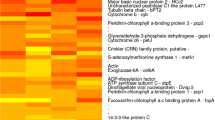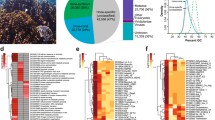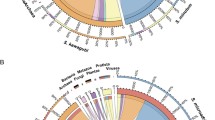Abstract
Hermatypic (reef-building) corals harbor dinoflagellate endo-symbionts Symbiodinium spp. In studying gene expression in such symbiotic corals, problems arise regarding how to distinguish the coral and symbiont mRNA, and how to estimate their fractions in the mRNA population of the holobiont (symbiotic complex of the coral and Symbiodinium cells). In this study, these issues were addressed using juveniles of hermatypic coral Acropora tenuis in symbiosis with Symbiodinium cells of strain PL-TS-1. First, the guanine-cytosine (GC) contents were determined in expressed sequence tags (EST) from PL-TS-1 cells cultured in vitro and symbiont-free larvae of A. tenuis, and their average GC contents were found to be significantly different. The average GC content of the EST from the holobiont was much closer to that of A. tenuis larvae, suggesting that the majority (>90%) of mRNA isolated from the holobiont originated in the host. In protein-coding sequences, little overlap was observed between the GC-content distributions of PL-TS-1 cells and A. tenuis larvae. All of the coding sequences (n=59) found in the A. tenuis EST had GC contents below 0.5, whereas the GC content exceeded 0.5 in the majority (43/44) of coding sequences from the nuclear genome of PL-TS-1 cells.
Similar content being viewed by others
References
Veron JEN. Corals of the World, Australian Institute of Marine Science, Townsville, Queensland. 2000.
Trench RK. Dinoflagellates in non-parasitic symbioses. In: Taylor FJR (ed.). The Biology of Dinoflagellates. Blackwell Scientific Publications, Oxford, 1987; 530–570.
Karako S, Stambler N, Dubinsky N. The taxonomy and evolution of the zooxanthellae-coral symbiosis. In: Seckbach J (ed.), Symbiosis: Mechanisms and Model Systems. Kluwer Academic Publishers, Dordrecht. 2002; 541–557.
Baker AC. Flexibility and specificity in coral-algal symbiosis: diversity, ecology, and biogeography of Symbiodinium. Annu. Rev. Ecol. Evol. Syst. 2003; 34: 661–689.
Coffroth MA, Santos SR. Genetic diversity of symbiotic dinoflagellates in the genus Symbiodinium. Protist 2005; 156: 19–34.
Stat M, Carter D, Hoegh-Guldberg O. The evolutionary history of Symbiodinium and scleractinian hosts — Symbiosis, diversity and the effect of climate change. Perspect. Plant Ecol. Evol. Syst. 2006; 8: 23–43.
Muscatine L. The role of symbiotic algae in carbon and energy flux in reef corals. In: Dubinsky Z (ed.). Coral Reefs: Ecosystems of the World, Vol. 25. Elsevier, Amsterdam, 1990; 75–87.
Harrison PL, Wallace CC. Reproduction, dispersal and recruitment of scleractinian corals. In: Dubinsky Z (ed.). Coral Reefs: Ecosystems of the World, Vol. 25. Elsevier, Amsterdam. 1990, 133–207.
Brown BE. Coral bleaching: causes and consequences. Coral Reefs 1997; 16: S129-S138.
Kushmaro A, Banin E, Loya Y, Stackebrandt E, Rosenberg E. Vibrio shiloi sp nov., the causative agent of bleaching of the coral Oculina patagonica. Int. J. Syst. Evol. Microbiol. (Pt 4) 2001; 51: 1383–1388.
Hughes TP, Baird AH, Bellwood DR, Card M, Connolly SR, Folke C, Grosberg R, Hoegh-Guldberg O, Jackson JBC, Kleypas J, Lough JM, Marshall P, Nystrom M, Palumbi SR, Pandolfi JM, Rosen B, Roughgarden J. Climate change, human impacts, and the resilience of coral reefs. Science 2003; 301: 929–933.
Watanabe T, Yuyama I, Yasumura S. Toxicological effects of biocides on symbiotic and aposymbiotic juveniles of the hermatypic coral Acropora tenuis. J. Exp. Mar. Biol. Ecol. 2006; 339: 177–188.
Weis VM, Reynolds WS. Carbonic anhydrase expression and synthesis in the sea anemone Anthopleura elegantissima are enhanced by the presence of dinoflagellate symbionts. Physiol. Biochem. Zool. 1999; 72: 307–316.
Reynolds WS, Schwarz JA, Weis VM. Symbiosis-enhanced gene expression in cnidarian-algal associations: cloning and characterization of a cDNA, sym32, encoding a possible cell adhesion protein. Comp. Biochem. Physiol. Pt A 2000; 126: 33–44.
Richter S, Furla P, Plantivaux A, Merle P-L, Allemand D. Symbiosis-induced adaptation to oxidative stress. J. Exp. Biol. 2005; 208: 277–285.
Rodriguez-Lanetty M, Phillips WS, Weis VM. Transcriptome analysis of a cnidarian-dinoflagellate mutualism reveals complex modulation of host gene expression. BMC Genomics 2006; 7: Article No. 23.
Yuyama I, Hayakawa H, Endo H, Iwao K, Takeyama H, Maruyama T, Watanabe T. Identification of symbiotically expressed coral mRNAs using a model infection system. Biochem. Biophys. Res. Commun. 2005; 336: 793–798.
Barneah O, Benayahu Y, Weis V. Comparative proteomics of symbiotic and aposymbiotic juvenile soft corals. Mar. Biotechnol. 2006; 8: 11–16.
Mooers AØ, Holmes EC. The evolution of base composition and phylogenetic inference. Trends Ecol. Evol. 2000; 15: 365–369.
Watanabe T, Kii S, Tanaka J, Takishita K, Maruyama T. cDNA cloning, and phylogenetic and expression analyses of actin in symbiotic dinoflagellates (Symbiodinium spp.). J. Appl. Phycol. 2006; 18: 219–225.
Zhang ZD, Cavalier-Smith T, Green BR. A family of selfish minicircular chromosomes with jumbled chloroplast gene fragments from a dinoflagellate. Mol. Biol. Evol. 2001; 18: 1558–1565.
Zhang H, Bhattacharya D, Lin S. Phylogeny of dinoflagellates based on mitochondrial cytochrome b and nuclear small subunit rDNA sequence comparisons. J. Phycol. 2005; 41: 411–420.
Saccone C, De Giorgi C, Gissi C, Pesole G, Reyes A. Evolutionary genomics in Metazoa: the mitochondrial DNA as a model system. Gene 1999; 238: 195–209.
Chaput H, Wang Y, Morse D. Polyadenylated transcripts containing random gene fragments are expressed in dinoflagellate mitochondria. Protist 2002; 153: 111–122.
Bachvaroff TR, Concepcion GT, Rogers CR, Herman EM, Delwiche CF. Dinoflagellate expressed sequence tag data indicate massive transfer of chloroplast genes to the nuclear genome. Protist 2004; 155: 65–78.
Hackett JD, Yoon HS, Soares MB, Bonaldo MF, Casavant TL, Scheetz TE, Nosenko T, Bhattacharya D. Migration of the plastid genome to the nucleus in a peridinin dinoflagellate. Curr. Biol. 2004; 14: 213–218.
Zhang ZD, Green BR, Cavalier-Smith T. Single gene circles in dinoflagellate chloroplast genomes. Nature 1999; 400: 155–159.
Kortschak RD, Samuel G, Saint R, Miller DJ. EST analysis of the cnidarian Acropora millepora reveals extensive gene loss and rapid sequence divergence in the model invertebrates. Curr. Biol. 2003; 13: 2190–2195.
Kuo J, Chen MC, Lin CH, Fang LS. Comparative gene expression in the symbiotic and aposymbiotic Aiptasia pulchella by expressed sequence tag analysis. Biochem. Biophys. Res. Commun. 2004; 318: 176–186.
Author information
Authors and Affiliations
Corresponding author
Rights and permissions
About this article
Cite this article
Kii, S.I., Tanaka, J. & Watanabe, T. Guanine-cytosine contents of the host and symbiont cDNA in a symbiotic coral. Fish Sci 73, 1362–1372 (2007). https://doi.org/10.1111/j.1444-2906.2007.01479.x
Received:
Accepted:
Issue Date:
DOI: https://doi.org/10.1111/j.1444-2906.2007.01479.x




